1:Company Information
Established in 2002, Haining Hongying Decoration Material Factory, is specialized in PVC panel, PVC ceiling, PVC wall panel, UPVC decoration materials, PC sheet, PC hollow sheet, PVC siding. Our construction area is more than 10000 square meters. Number of workers is more than 100.

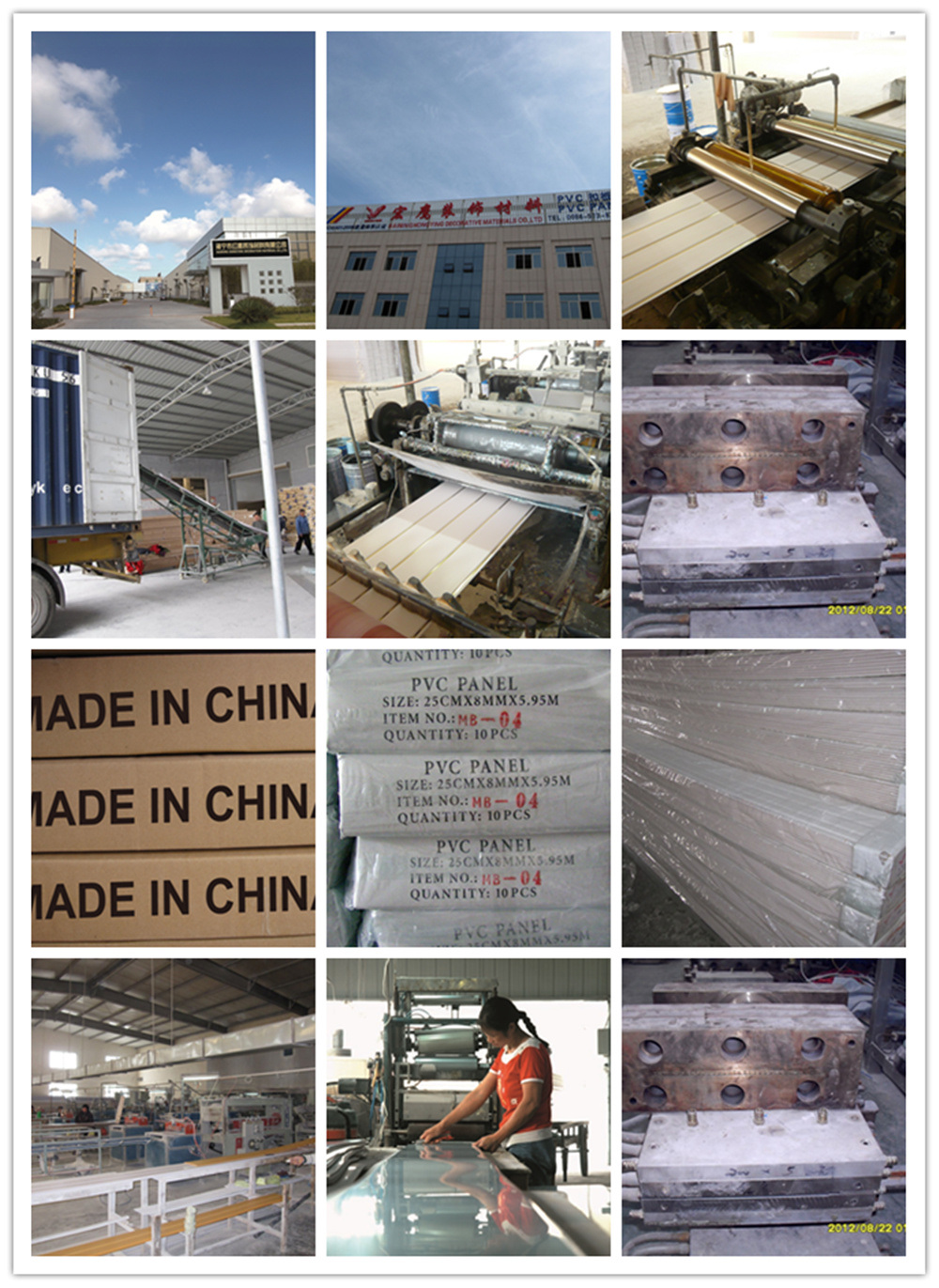
2:About products
PVC ceiling & wall panel are used for ceiling and wall.
1) Fetures: Wearing resistence, water proof, flame retarding, aging resistence, smoothness, flatness, moth-proof.
2) Proof. Light in weight and easy to install.
3) Width: 10cm, 16cm, 20cm, 25cm, 30cm, 38cm
4) Length: 5.8m for 20'GP and 5.95m for 40'HQ.
5) Thickness: 5mm, 6mm, 7mm, 7.5mm, 8mm, 8.5mm, 9mm, 9.5mm, 10mm, 12mm.
6) Weight: 1.8kg, 2.0kg, 2.4kg, 2.6kg, 2.75kg, 3.12kg, 3.25kg, 4.3kg
7) PVC%: 40%, 45%, 50%, 60%.
8) Surface: Printed, Filmed, High glossy surface, more than 3000 colors available for surface treatment.
3:Product application cases
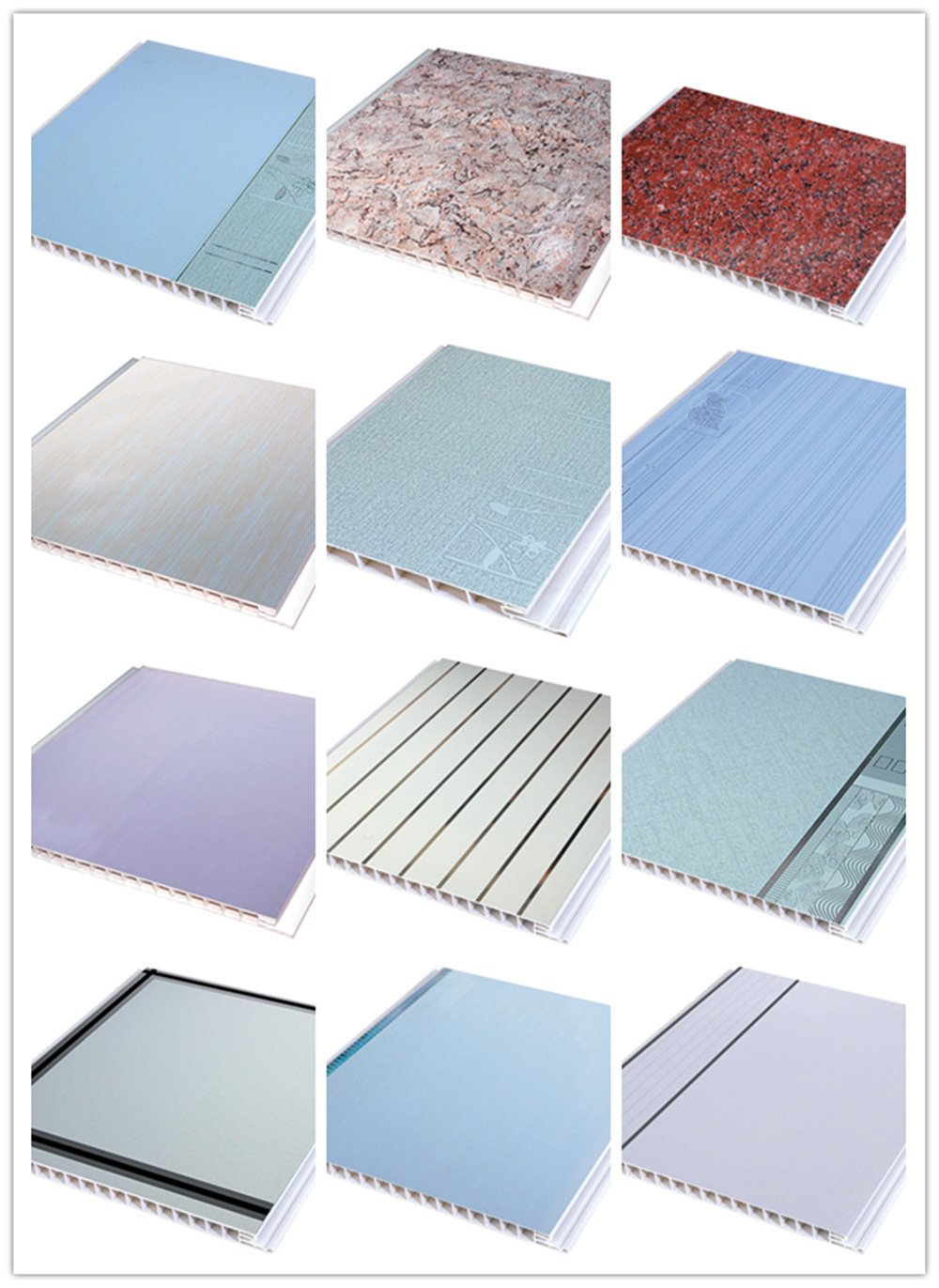

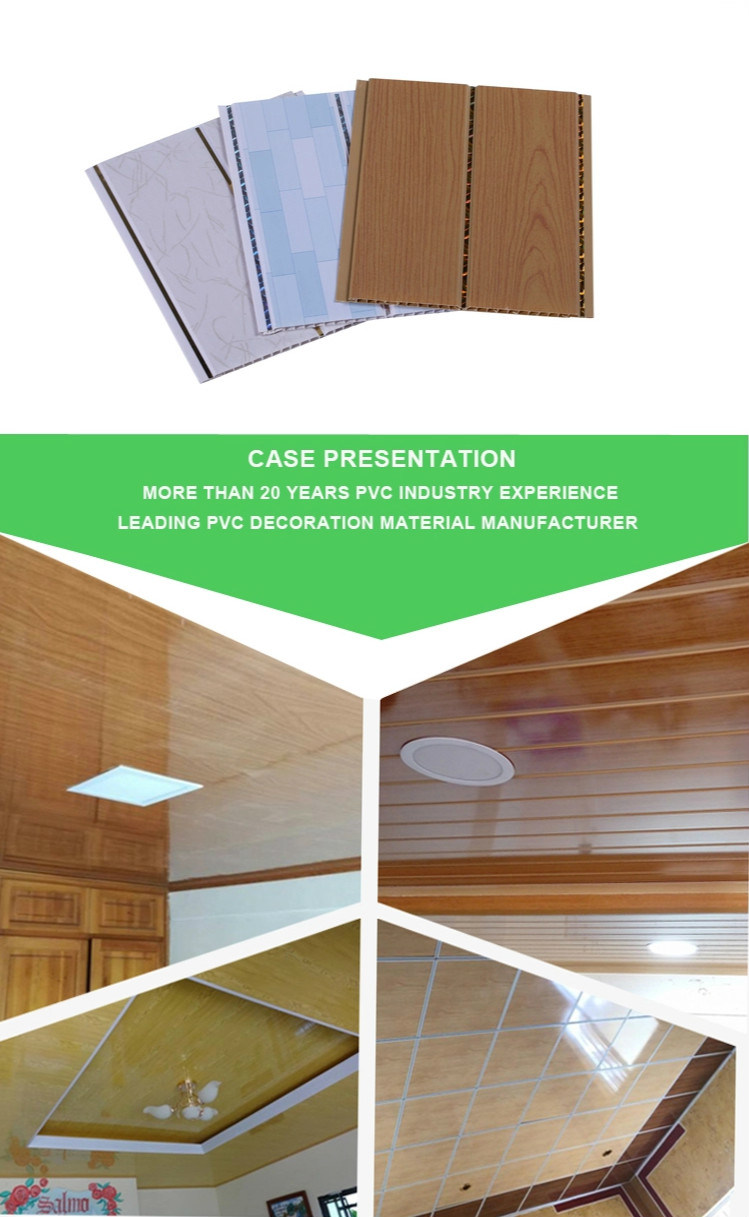
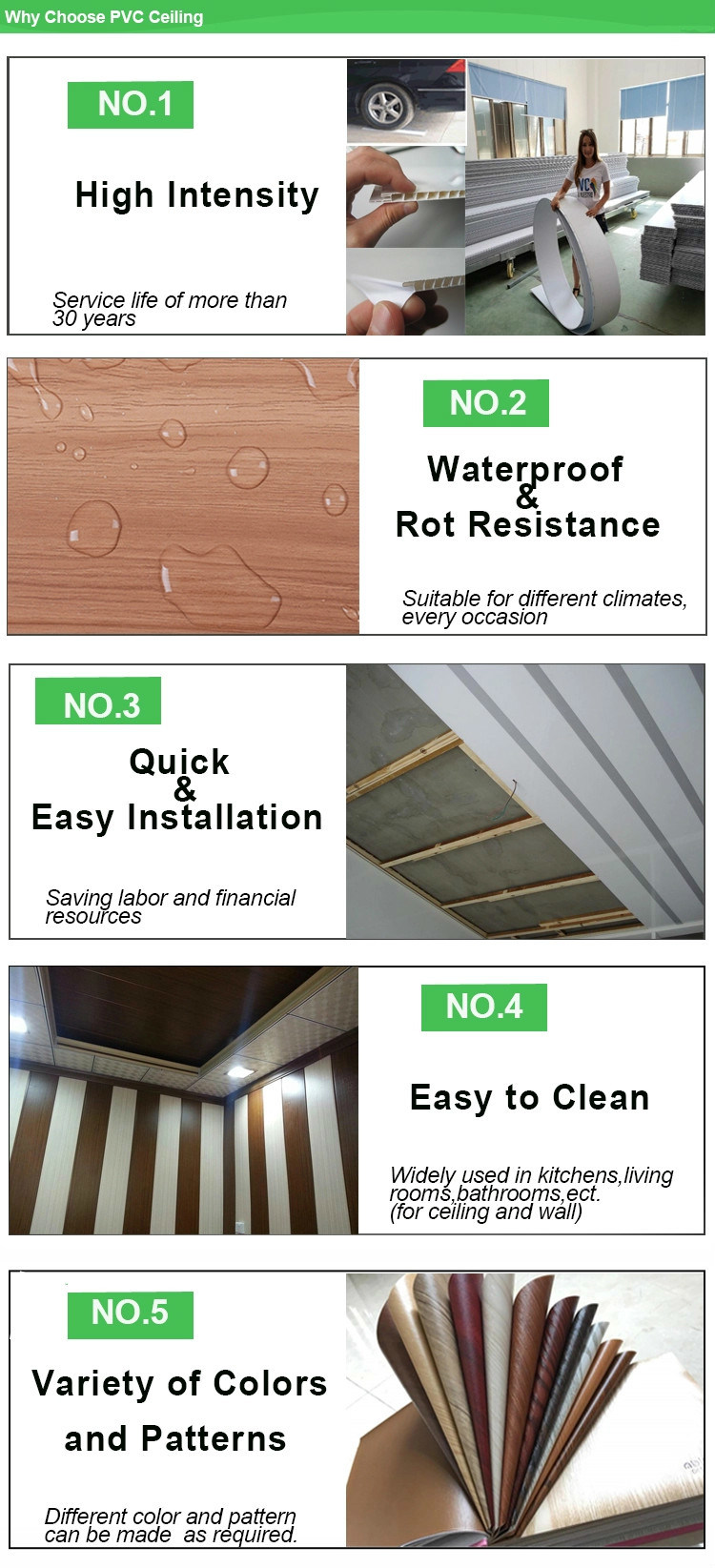
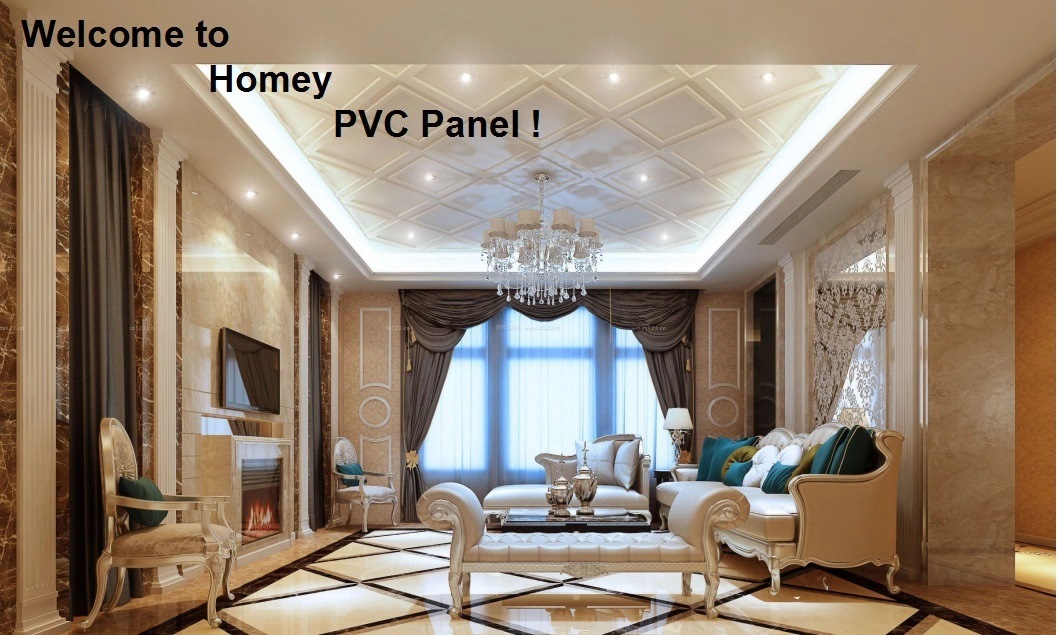
4:Accessories
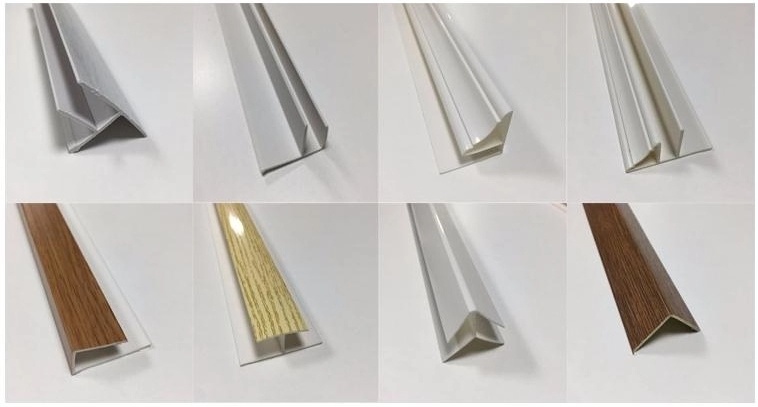
pvc panels as the important material used in building industry. how it is installed? we show you the correct installation for your pvc panels for walls and ceilings. you may find yourself an export in installing pvc panels after reading through this s
Installation Instructions What you have to remember:
Use the panel for indoor uses only.
The background must be sound, dry and in good condition.
When using the panels in high pressure shower areas, use silicon sealant in the
groove on the back of the lip for a water-tight seal.
Before fitting panels around sources of heat, for example radiators or fire places,
make sure the temperature level doesn't exceed allowed level of 140ºF (60ºC).
Decorative plastic panels are a decorative covering that offers many benefits as they are
waterproof, maintenance free, extremely versatile and very easy to install. Our panels can be easily applied to any surface. By fitting them yourself using our easy guide, you won't have to hire costly professionals.
All pvc panels are tongue and groove and need only simple tools to fit and attach them.
Plastic panels can be stuck to any surface including uneven surfaces, with little or no
preparation required. Decorative plastic also offer a range of finishing accessories such as edge trims, internal and external corners, cornice trims and skirting boards that ease the task of fitting and ensure a perfect finish, whatever your room is shaped.
Surface preparation In the majority of the cases there is virtually no preparation needed - the panels can go straight onto brick, cement block, plaster, timber wall studs or stud-work and can even go over existing ceramic tiles.
Sometimes bathrooms are half-tiled. In that case tiles can be left in place and the top half leveled out to the same level. Before starting installation, make sure that the extra thickness of the wall paneling does not interfere with the operation of existing fixtures such as bath taps, shower mixer valves and doors. If the surface is very uneven, wall studs can be used to achieve a level surface and then the panels can be attached to the wall studs. Position studs with 1 to 2 ft (30 to 60 cm) intervals.
The use of studs allows you to install cables for switches, plugs for power supply, phones
sockets etc. Pl.s note that building codes might require that panels thinner than 1/4" be
installed over a non-combustible backer over timber studs. Such panels should be installed over a solid, non-combustible backing such as gypsum wallboard.
Cutting the Panels
Panels can be easily cut or trimmed using a hand saw, table saw, portable circular saw, jig saw or sharp utility knife. We recommend using a fine-tooth saw. The finer the teeth, the neater the cut you will achieve.
Installation
Panels are normally fixed vertically i.e. from floor to ceiling; however panels may also be fitted horizontally if the shape of the room makes this an easier option. Similarly, ceiling panels can be run in either direction. Of course, you may have a preference as to which way you would like run the panels for visual effect.
Fitting Instructions:
Decorative plastic panels are easily fixed to almost every surface. Depending on the type of wall or ceiling you can choose different types of fitting.
Nailing:
Apply nails evenly and level in the panel lip. Be careful not to hit the panel with the hammer.This method only applies when fixing the cladding to a wooden surface or battening. Make sure the battening is flat and level, packing out where necessary on uneven walls so that when applied the cladding does not develop curvature and follow the walls contours. In cases of damp and uneven walls we recommend the use of treated timbers for battening. Ensure that you leave sufficient ventilation behind the cladding by providing air gap.
Screw fix:
Apply screws through the panel lip as shown in the diagrams below. Screw fixing can be made to wooden wall studs. However breezeblock, brick or plasterboard will require the wall to be plugged before screwing. When the first plank is fixed in place the next conceals the previous fixing see diagram below.
Stapling:
You can use stainless steel staples when fixing to plaster or wooden wall studs - this method is particularly suitable when using wall studs. Always make sure your wall studs are flat and level, packing them out where necessary on uneven walls, this will prevent the panels from developing a curvature following the wall contours.
Gluing:
This is the method most preferred by many installers however you can only use adhesive
when applied to a dry, even wall. The wall must be free of any greasy substances and dust.Only use specialist adhesive. Below is one of the methods aimed to minimize the use of trims and achieve very neat and professional look and feel:
Start working from one corner. If cornice will not be used to cover the top edge of the panel, then first fix start/end trim or cornice trim at the top along the wall where panels will be fixed.
Mitre the ceiling trims where necessary. First, trim off the tongue of the first panel. Apply adhesive to the back of the panels or onto the wall or wall studs. Insert panel into the ceiling trim, if installed and slide it into its position in the corner. Make sure that it is placed vertically before fixing it to the wall.
Slightly tap the panel to achieve better adhesion. Fix panel in place with staples through the lip on the groove side of the panel. Follow the same procedure to fix the first panel along the other wall from the start corner. Make sure that the gap between panels in the corner is small enough to be properly sealed by silicone. If the gap is too big (for example, due to the walls being not plumb), trim the panels accordingly to minimize the gap.
Continue installation along one of the walls by inserting the next panel into the groove of the first panel. Carefully measure, mark and cut the last panel to closely fit into its position on the wall. Follow the same steps to finish all the walls. Use a fine tooth hole-saw to make holes for taps, pipes, etc. Always measure twice and with care. When all walls are covered use neutral cure silicone (anti-fungal silicones recommended) to seal the corners and horizontal joints against baths or shower trays as well as the gaps between panels and bathroom fixtures.
The joints between the panels do not need to be sealed, but in a shower area a thin bead of silicone can be applied between tongue and groove to ensure complete protection against moisture - just to be on the safe side.
Apart from using trims (pictured above), both internal and external corners can be neatly done by bending the panels - just carefully cut the back face of the board along where the corner will be and shape the panel into the internal or external curve.
Ceilings:
Use the same installation technique when fitting panels onto the ceilings - apply adhesive to an existing ceiling or wall studs and fix the panel with staples to hold it in place.
When fitting halogen ceiling lights there needs to be a 10mm gap between the halogen bulb and the panel. Once the panels are installed there might be other items that you need to fix to the walls, such as soap dishes, shower curtain rails, etc. For lightweight items you can fix directly to the panels using plaster plugs or through the panel into the wall. For larger or heavier items you it is recommended that you fix wooden wall studs behind panels where accessories are to be fixed. Use of spacers between the wall and the surface of the fixed panels is also recommended when fitting heavy items
5:Packaging & Shipping
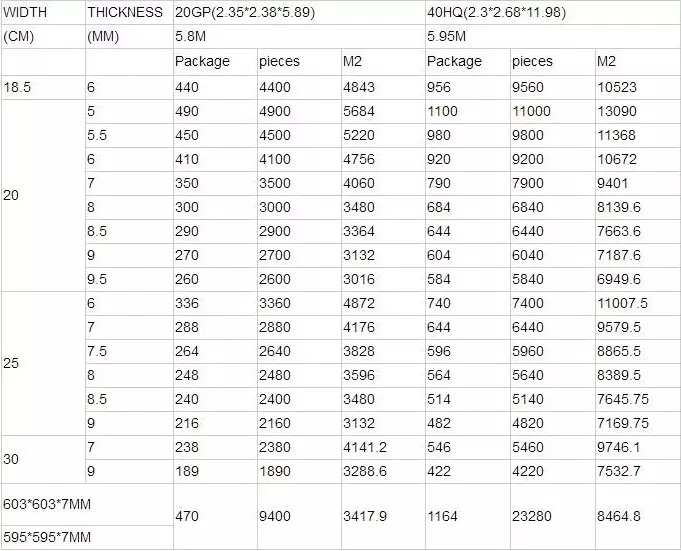
Q: What is the MOQ?
A: 20ft container or 3000 square meter.
Q: What is your delivery time?
A: Within 15 days since receipt of 30% T/T deposit.
Q: Do you charge for the sample?
A: According to company policy, free sample will be provided, but the freight charges need
customers pay.
Q: What kind of of payments do you support?
A: T/T, L/C
Q: What is your package?
A: PE film or Carton.
Q: How many moulds do you have?
A: Dear friend, our moulds cover almost all the popular size in different. And if you require special
size, we can open new mould for you, and if your order is big enough, or it's our honor to be your
regular manufacturer, we can delete the fee of your special mould.
Q: Where are your main markets?
A: Dear friend, our markets coverd Middle East, South America, South Asia, Southeast Asia, East
Europe and Africa
Established in 2002, Haining Hongying Decoration Material Factory, is specialized in PVC panel, PVC ceiling, PVC wall panel, UPVC decoration materials, PC sheet, PC hollow sheet, PVC siding. Our construction area is more than 10000 square meters. Number of workers is more than 100.


2:About products
PVC ceiling & wall panel are used for ceiling and wall.
| width | 10cm,12cm,16cm,20cm,25cm,30cm,38cm,60cm |
| thickness | 4mm,4.5mm,5mm,6mm,7mm,7.5mm,8mm,8.5mm,9mm,9.5mm,10mm,12mm |
| length | 5.8m , 5.95m , or by customer require |
| pvc content | 35%,40%,45%,50%,60%, 70% |
| surface finishing | printing , high glossy like mirror , semi glossy , transfer printed |
| mini order | one 20' container |
| delivery date | within 20 days after prepayment |
| payment term | 30% prepayment , 70% before shipment |
| packing | by pe film or by carton |
| exported areas or countries | Georgia,Ukraine , Ghana , Russia , Iraq |
1) Fetures: Wearing resistence, water proof, flame retarding, aging resistence, smoothness, flatness, moth-proof.
2) Proof. Light in weight and easy to install.
3) Width: 10cm, 16cm, 20cm, 25cm, 30cm, 38cm
4) Length: 5.8m for 20'GP and 5.95m for 40'HQ.
5) Thickness: 5mm, 6mm, 7mm, 7.5mm, 8mm, 8.5mm, 9mm, 9.5mm, 10mm, 12mm.
6) Weight: 1.8kg, 2.0kg, 2.4kg, 2.6kg, 2.75kg, 3.12kg, 3.25kg, 4.3kg
7) PVC%: 40%, 45%, 50%, 60%.
8) Surface: Printed, Filmed, High glossy surface, more than 3000 colors available for surface treatment.
| Product Detail | Specification |
| Product name | PVC Ceiling Panel |
| Thickness(mm) | 4.5mm, 5mm, 6mm, 7mm, 7.5mm, 8mm, 9mm, 10mm |
| Width(mm) | 180mm, 200mm, 250mm, 300mm |
| Length(m) | 2.9m, 2.95m, 3.05m, 5.8m(for 20'GP), 5.95m(for 40'HQ) |
| Weight(kg/m2) | 2.0kg/sqm ~ 5.0kg/sqm |
| Surface Finishing | Printing (high glossy or glossy matte ), Hot stamping,Lamination. |
| Main Material | PVC resin,Calcium carbonate |
| Delivery Detail | 15~20 days for 1*40HQ container after receiving down payment. |
3:Product application cases





4:Accessories

How to install PVC Panels
pvc panels as the important material used in building industry. how it is installed? we show you the correct installation for your pvc panels for walls and ceilings. you may find yourself an export in installing pvc panels after reading through this s
Installation Instructions What you have to remember:
Use the panel for indoor uses only.
The background must be sound, dry and in good condition.
When using the panels in high pressure shower areas, use silicon sealant in the
groove on the back of the lip for a water-tight seal.
Before fitting panels around sources of heat, for example radiators or fire places,
make sure the temperature level doesn't exceed allowed level of 140ºF (60ºC).
Decorative plastic panels are a decorative covering that offers many benefits as they are
waterproof, maintenance free, extremely versatile and very easy to install. Our panels can be easily applied to any surface. By fitting them yourself using our easy guide, you won't have to hire costly professionals.
All pvc panels are tongue and groove and need only simple tools to fit and attach them.
Plastic panels can be stuck to any surface including uneven surfaces, with little or no
preparation required. Decorative plastic also offer a range of finishing accessories such as edge trims, internal and external corners, cornice trims and skirting boards that ease the task of fitting and ensure a perfect finish, whatever your room is shaped.
Surface preparation In the majority of the cases there is virtually no preparation needed - the panels can go straight onto brick, cement block, plaster, timber wall studs or stud-work and can even go over existing ceramic tiles.
Sometimes bathrooms are half-tiled. In that case tiles can be left in place and the top half leveled out to the same level. Before starting installation, make sure that the extra thickness of the wall paneling does not interfere with the operation of existing fixtures such as bath taps, shower mixer valves and doors. If the surface is very uneven, wall studs can be used to achieve a level surface and then the panels can be attached to the wall studs. Position studs with 1 to 2 ft (30 to 60 cm) intervals.
The use of studs allows you to install cables for switches, plugs for power supply, phones
sockets etc. Pl.s note that building codes might require that panels thinner than 1/4" be
installed over a non-combustible backer over timber studs. Such panels should be installed over a solid, non-combustible backing such as gypsum wallboard.
Cutting the Panels
Panels can be easily cut or trimmed using a hand saw, table saw, portable circular saw, jig saw or sharp utility knife. We recommend using a fine-tooth saw. The finer the teeth, the neater the cut you will achieve.
Installation
Panels are normally fixed vertically i.e. from floor to ceiling; however panels may also be fitted horizontally if the shape of the room makes this an easier option. Similarly, ceiling panels can be run in either direction. Of course, you may have a preference as to which way you would like run the panels for visual effect.
Fitting Instructions:
Decorative plastic panels are easily fixed to almost every surface. Depending on the type of wall or ceiling you can choose different types of fitting.
Nailing:
Apply nails evenly and level in the panel lip. Be careful not to hit the panel with the hammer.This method only applies when fixing the cladding to a wooden surface or battening. Make sure the battening is flat and level, packing out where necessary on uneven walls so that when applied the cladding does not develop curvature and follow the walls contours. In cases of damp and uneven walls we recommend the use of treated timbers for battening. Ensure that you leave sufficient ventilation behind the cladding by providing air gap.
Screw fix:
Apply screws through the panel lip as shown in the diagrams below. Screw fixing can be made to wooden wall studs. However breezeblock, brick or plasterboard will require the wall to be plugged before screwing. When the first plank is fixed in place the next conceals the previous fixing see diagram below.
Stapling:
You can use stainless steel staples when fixing to plaster or wooden wall studs - this method is particularly suitable when using wall studs. Always make sure your wall studs are flat and level, packing them out where necessary on uneven walls, this will prevent the panels from developing a curvature following the wall contours.
Gluing:
This is the method most preferred by many installers however you can only use adhesive
when applied to a dry, even wall. The wall must be free of any greasy substances and dust.Only use specialist adhesive. Below is one of the methods aimed to minimize the use of trims and achieve very neat and professional look and feel:
Start working from one corner. If cornice will not be used to cover the top edge of the panel, then first fix start/end trim or cornice trim at the top along the wall where panels will be fixed.
Mitre the ceiling trims where necessary. First, trim off the tongue of the first panel. Apply adhesive to the back of the panels or onto the wall or wall studs. Insert panel into the ceiling trim, if installed and slide it into its position in the corner. Make sure that it is placed vertically before fixing it to the wall.
Slightly tap the panel to achieve better adhesion. Fix panel in place with staples through the lip on the groove side of the panel. Follow the same procedure to fix the first panel along the other wall from the start corner. Make sure that the gap between panels in the corner is small enough to be properly sealed by silicone. If the gap is too big (for example, due to the walls being not plumb), trim the panels accordingly to minimize the gap.
Continue installation along one of the walls by inserting the next panel into the groove of the first panel. Carefully measure, mark and cut the last panel to closely fit into its position on the wall. Follow the same steps to finish all the walls. Use a fine tooth hole-saw to make holes for taps, pipes, etc. Always measure twice and with care. When all walls are covered use neutral cure silicone (anti-fungal silicones recommended) to seal the corners and horizontal joints against baths or shower trays as well as the gaps between panels and bathroom fixtures.
The joints between the panels do not need to be sealed, but in a shower area a thin bead of silicone can be applied between tongue and groove to ensure complete protection against moisture - just to be on the safe side.
Apart from using trims (pictured above), both internal and external corners can be neatly done by bending the panels - just carefully cut the back face of the board along where the corner will be and shape the panel into the internal or external curve.
Ceilings:
Use the same installation technique when fitting panels onto the ceilings - apply adhesive to an existing ceiling or wall studs and fix the panel with staples to hold it in place.
When fitting halogen ceiling lights there needs to be a 10mm gap between the halogen bulb and the panel. Once the panels are installed there might be other items that you need to fix to the walls, such as soap dishes, shower curtain rails, etc. For lightweight items you can fix directly to the panels using plaster plugs or through the panel into the wall. For larger or heavier items you it is recommended that you fix wooden wall studs behind panels where accessories are to be fixed. Use of spacers between the wall and the surface of the fixed panels is also recommended when fitting heavy items
5:Packaging & Shipping

Q: What is the MOQ?
A: 20ft container or 3000 square meter.
Q: What is your delivery time?
A: Within 15 days since receipt of 30% T/T deposit.
Q: Do you charge for the sample?
A: According to company policy, free sample will be provided, but the freight charges need
customers pay.
Q: What kind of of payments do you support?
A: T/T, L/C
Q: What is your package?
A: PE film or Carton.
Q: How many moulds do you have?
A: Dear friend, our moulds cover almost all the popular size in different. And if you require special
size, we can open new mould for you, and if your order is big enough, or it's our honor to be your
regular manufacturer, we can delete the fee of your special mould.
Q: Where are your main markets?
A: Dear friend, our markets coverd Middle East, South America, South Asia, Southeast Asia, East
Europe and Africa